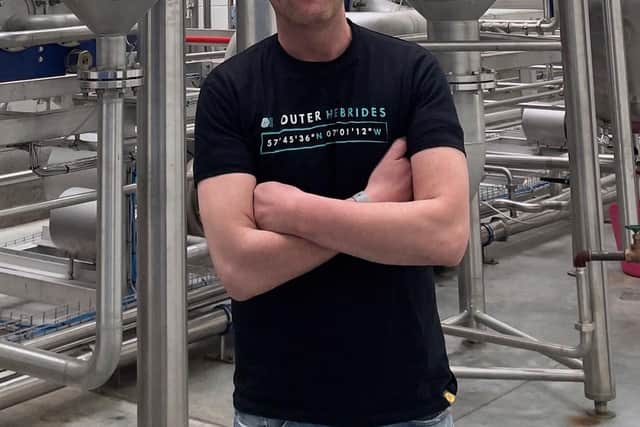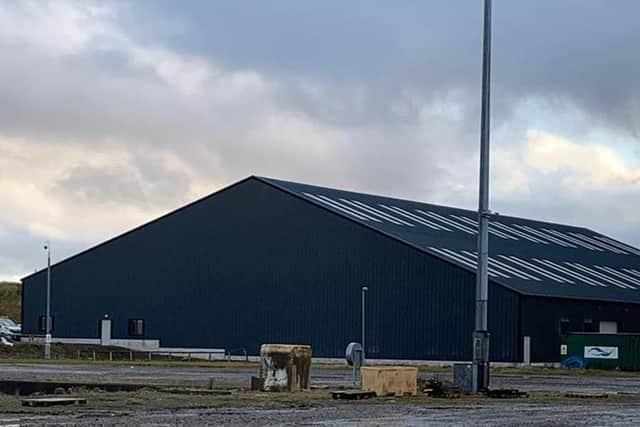Seaweed: A story of growing ingenuity


As anyone who knows Martin MacLeod will confirm, starting him talking about what can be done with seaweed is the easy bit. Stopping him is more difficult. There are just so many directions in which to take the conversation and all of them have a habit of turning into reality.
Last year, the Hebridean Seaweed plant at Arnish trebled in size. Nobody really noticed because most of it happened during the pandemic but the transformation is extraordinary. The basic operation is still there, processing seaweed for agriculture feed – the bread and butter, so to speak. The rest is dedicated to adding value. Martin says: “This factory has been built with a view to becoming very scientific about everything”.
Advertisement
Hide AdAdvertisement
Hide AdTake bio-stimulants, which happen to be ready for dispatch when we meet. All over the world, there are conditions in which crops won’t grow. The ground is either too hard because of the heat or too wet because of rain. Spray the crops with a little seaweed and the prospects are transformed. Huge tanks of liquid – seaweed concentrated and then diluted – are about to leave Arnish for Mexico, but it could be pretty much anywhere.


As with much else about seaweed, there is nothing new in this. “I used to make this stuff in Keose when I was 18, in an old 1000 litre tank from Joe Black’s dairy,” says Martin. “There was no health or safety or protective clothing in these days. But it’s the same stuff doing the same job. It’s just about getting a route to market and more people understanding what it can do”.
It is also, of course, about a great deal of knowledge and ingenuity as well as maintaining quality standards for international customers that a tank from Joe Black’s dairy might not have satisfied. On every front, Hebridean Seaweed is a shrewd, highly intelligent operation, dealing constantly with new opportunities. It is also the biggest seaweed processor in the United Kingdom.
Ten years ago, on another front, the big food manufacturers started getting wise to the fact time was catching up on them over the use of salt in processed foods. Seaweed could do much the same job as a preservative. Today, tens of millions of ready meals contain a pinch of seaweed from Arnish, though few consumers will ever know it. To take just one example, two tonnes of powdered seaweed go into 40 million packets of Batchelor’s pasta sauce each year.
Advertisement
Hide AdAdvertisement
Hide AdMartin says: “It’s impossible now to keep track of where it is going – but there is hardly a country in the world without products that contain our seaweed. Some manufacturers don’t like to mention it in case it puts people off. Others promote it as a health food. Either way, the demand just keeps growing”.


One of the main spin-offs from the basic business has been Ishga, the ultra-fashionable range of seaweed based cosmetic products which now graces a dazzling array of up-market spas and hotels. It also, incidentally, made Martin one of the few Lewismen to have actually met the island’s most prodigal son, Donald Trump
On a visit to Turnberry before he was president, Trump liked the Ishga products before he had any knowledge of where they came from. Martin was summoned to meet the great man and found him “ok, he was very pleasant – the first man I’d met with bodyguards”. Then he became President but connections with the Trump empire have been maintained.
On the golf front, it is less controversial for Ishga to sponsor ladies golf – the Solheim Cup and UK Women’s Open.
Advertisement
Hide AdAdvertisement
Hide AdTwo agencies which played key roles in the Hebridean Seaweed story were the French competition authority and Stornoway Golf Club. For the former, we have to track back to 1979 and the sale of Alginate Industries to the Californian seaweed behemoth, Kelco.
Alginate Industries had invented the Scottish seaweed industry in its modern form with three post-war drying plants in the Western Isles – first at Orasay in South Uist, then Sponish in North Uist and Keose in Lewis. They had also established plants in Connemara and Donegal, in partnership with the Irish Government.
While Alginate Industries provided work for cutters and factory workers, there was no value added in the islands before the dried weed was shipped off to mainland plants at Barcaldine and Girvan. Nonetheless, with Kelco about to move into Europe, the French saw a threat to their own industry and insisted, rather oddly, that one of the island plants – Keose – must be divorced from the sale.
This proved a providential blessing in disguise. Having promised to retain the Uist plants, Kelco promptly closed them. Keose would have gone the same way. However, having been left outside the sale, it continued to operate as a local co-operative with six members, led by the manager Dixie MacLean. The problem was that its only customer was Kelco’s mainland plants with little potential for diversification.
Advertisement
Hide AdAdvertisement
Hide AdRemarkably, though, the Keose operation kept going independently for more than 20 years, latterly as Tavay Organic Products owned by local businessman, John Alex MacKenzie. This was the company that Martin joined in 1994, originally as a summer job. Four years later, when Dixie suffered health problems, Martin became manager but by 2003, as the machinery finally gave up the ghost, the Keose operation closed.
By then, however, Martin had learned enough to appreciate the potential of seaweed for far, far more extensive uses than had ever been contemplated in the islands. This was where Stornoway Golf Club became significant. Martin’s Winter League partner was Malcolm MacRae, a biochemist with a Master’s degree and also from Leurbost. Over many pints, the idea of Hebridean Seaweed was born.
Martin still had contacts among Tavay’s old customers who were desperate for the stuff. That gave Highlands and Islands Enterprise the confidence to support the venture and the Arnish factory opened in 2005, almost entirely devoted to turning the gathered seaweed into animal feed. But very soon, they were also working on the clever stuff which would add value – and that is what had never been done in the islands before.
Before any value can be added, however, the seaweed has to be gathered and much of Hebridean Seaweed’s early creativity was devoted to doing that more efficiently than had ever been possible with manual cutting. They needed machines which could get into the nooks and crannies of the west coast. Sophisticating these amphibious units is a process that has never stopped – there are now six of them.
Advertisement
Hide AdAdvertisement
Hide AdMartin says: “We are looking ultimately to build them ourselves at Arnish using all sorts of technology to ensure they can cope with Hebridean weather and the rocky coastline. This is a much more sustainable form of harvesting as it allows us back every couple of years to our sites”.
The key to understanding seaweed’s versatility is the fact there are so many varieties, each with its own properties. “We deal with six different species at the moment, primarily Ascophyllum nodosum, for animal feed and horticulture. We are constantly looking at different species, uses and speciality markets. In our waters, there are probably over 100 different species; around the world there are thousands”.
Last year, Charles Cameron – now a centenarian – published his own account of the Hebridean seaweed history. He joined Alginate Industries in 1948 as manager of the Orasay factory and – as befitted a Cameron of Locheil in these days – became an Inverness County Councillor representing South Uist.
He recalled: “At that time, the product was mainly used as a suspension agent for ice cream and had a good market in Australia.
Advertisement
Hide AdAdvertisement
Hide Ad"About a year after I joined, it was discovered that many alginates could be made from Ascophyllum nodosum, or rockweed, so a new drier was built for this, and more collectors were recruited.
“This was more of a full-time occupation although the cutting of the seaweed could only be done at spring tides. Boats and nets had to be used for the collection of the seaweed, which was then transported over to the factory and dried there”.
Charles Cameron opened the Sponish factory and spent 38 years in the industry. “Seaweed was also imported from Norway and eventually from Tasmania where it was processed into meal and finally from Chile and Iceland,” he wrote.
“By this time many different products were being processed at the chemical factories and 60 per cent or more was being exported, for which we were given the government’s export award”.
Advertisement
Hide AdAdvertisement
Hide AdThe problem in the islands, however, was that none of this value was being added locally – so when the Kelco takeover occurred, there was really no economic case for retaining the Uist factories.
That is the massive difference between what happened then under Alginate Industries and what happens now, mainly through Hebridean Seaweed though there is also a relative newcomer in Uist.
In 2012, the entrepreneurial Johnston family in North Uist resurrected a locally-based gathering and processing business, Uist Asco, which was sold in 2017 to a Canadian company which also has plants in Ireland and the US state of Maine.
Charles Cameron wrote last year: “I often reflect on my days in the seaweed business and am once again optimistic that seaweed collection and processing is alive and well in Scotland. May it ever be thus”.
Advertisement
Hide AdAdvertisement
Hide AdAnd may it ever be thus that – finally - the benefits of this natural resource are harvested within the place where it is found and there are no cleaner waters or higher quality seaweed than around the Outer Hebrides of Scotland.